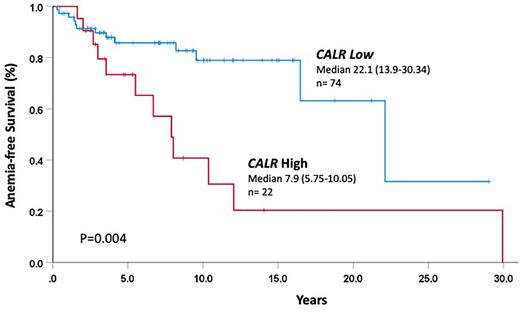Abstract
Introduction. Calreticulin (CALR) mutations represent the second most frequent driver mut in myeloproliferative neoplasms (MPN), accounting for 20-30% of patients (pts) with Essential Thrombocythemia (ET) and 25-35% Primary Myelofibrosis (PMF). There are 2 types of CALR mutation, Type 1/like (T1), a del52 bp deletion and similar, and Type 2/like (T2), a 5bp insertion and similar, both in exon 9. Most patients have CALR variant allele frequency (VAF) below 50% (conventionally defined as heterozygous, He), while a few were reported with higher VAF (homozygous, Ho). Homozygosity, that may be associated to LOH at chr19, is phenotypically hallmarked by MPO deficiency in myeloid cells. While well-defined hematologic, clinical and prognostics correlates of the VAF of JAK2V617F mutation were reported in MPN, little information is available regarding CALR.
Aim. The aim of the study was to characterize the hematological and clinical correlates of higher CALR VAF in a large population of CALR mut pts with primary (PMF) and PET-MF.
Patients and Methods. All patients with a confirmed WHO2016 and IWG-MRT diagnosis of PMF and PET-MF, respectively, available in our database, who were CALR mutated, were included. CALR mut was assayed by PCR amplification and capillary gel electrophoresis starting from peripheral blood granulocytes. The VAF was determined by automated interpolation of the area under the curve, and expressed as the mutant peak area divided by (mutant peak area + wild-type peak area). Mutation analysis of a panel of 40 myeloid neoplasm-associated genes was performed by NGS (Oncomine, ThermoFisher). The nonparametric Wilcoxon rank-sum test, Kaplan-Meier estimate of survival and log-rank test were used as appropriate.
Results. A total of 121 pts (42 prePMF, 34.7%; 36 overt PMF, 29.8%; 43 PET-MF, 35.5%) were considered. Overall, T1 was found in 87 pts (71.9%), of which 8 (6.6%) were T1-like; T2 in 34 pts (28-1%), of which 3 (2.5%) T2-like. The median CALR VAF was 51.4+10.4%. For the purposes of the analysis, we considered at Higher VAF (CALR-h) pts having a VAF of >95% confidence interval of the distribution in the population, ie a VAF >55%, compared to Lower VAF (CARL-l; <55%). CALR-h was found in 28 pts, accounting for 23.1% of the study population. The frequency of T1 and T2 variants was similar in CALR-h and CALR-l pts, 71% and 28% and 71% and 29%, respectively. There was a significant trend of increased representation of CALR-h pts from prePMF (n=6, 14.3%) to overt PMF (n=8, 22.2%) and PET-MF (n=14, 32.6%); no difference in T1 and T2 relative representation in the different diagnostic category. ASXL1 mut were enriched among CALR-h pts (13/28, 46.4% vs CALR-l, 24/87, 27.6%; P=0.04) as it was the presence of any >1 mutation in an NGS-panel of myeloid genes (CALR-h 82.5% vs 57.5% in CALR-l, P=0.02). However, limited to HMR mutations, no difference was outlined. There was no significant difference between CALR-h and CALR-l pts as regards gender, age, IPSS score, karyotype abnormalities, BM fibrosis grade, constitutional symptoms, splenomegaly, thrombosis and bleeding events at diagnosis. On the other hand, CALR-h pts had lower Hb level (10.8 g/dl (8.3-14.6) vs 12.1 (7.4-16); P=0.02) and platelet count (466x109/L (102-1053) vs 661 (57-1800; P=0.02), and higher peripheral blood CD34+ cell counts (62.2x106/L (4-3450) vs 16.9 (0-2100); P=0.01). A greater proportion of CALR-h pts developed anemia during the FU (median 5.5y, range 0.3-33y). KM analysis revealed an anemia-free survival (Hb <10g/dL) of 7.9y (5.7-10y) in CALR-h vs 22.1y (13.9-30.3y) in CALR-l pts, P=0.004 (Figure). The HR (95%CI) was 3.1 (1.4-7.0). Also leukocytosis-free survival (leukocytes >25x109/L) was shorter in CALR-h pts (P=0.04), HR 2.55 (1.0-6.6). A CALR-h status did not impact on overall survival nor leukemia-free survival even after stratification based on disease subtype.
Discussion. We found that about 20% of CALR mut MF pts harbor a higher VAF, here defined as VAF >55%, that is associated with a more anemic phenotype at diagnosis and greater risk of developing anemia in the FU; however, in spite of anemia development, overall survival was not significantly impacted in the different disease categories. Whether a CALR-h condition has different impact in ET remains to be assessed in a separate study.
Disclosures
Guglielmelli:Novartis, Abbvie: Other: Other member of advisory board, speaker at meeting. Coltro:Novartis: Speakers Bureau. Szuber:Novartis: Honoraria. Vannucchi:Geron: Membership on an entity's Board of Directors or advisory committees; AbbVie: Membership on an entity's Board of Directors or advisory committees, Speakers Bureau; Roche: Membership on an entity's Board of Directors or advisory committees; Morphosys: Membership on an entity's Board of Directors or advisory committees; GSK: Membership on an entity's Board of Directors or advisory committees, Speakers Bureau; BMS: Membership on an entity's Board of Directors or advisory committees, Speakers Bureau; Incyte: Membership on an entity's Board of Directors or advisory committees, Speakers Bureau; Blueprint: Membership on an entity's Board of Directors or advisory committees, Speakers Bureau; Novartis: Membership on an entity's Board of Directors or advisory committees, Speakers Bureau.
Author notes
Asterisk with author names denotes non-ASH members.


This feature is available to Subscribers Only
Sign In or Create an Account Close Modal